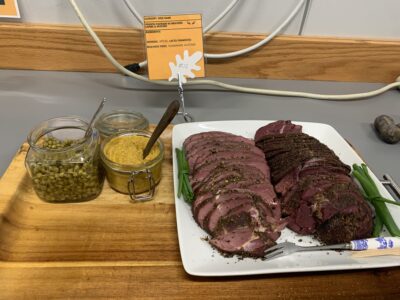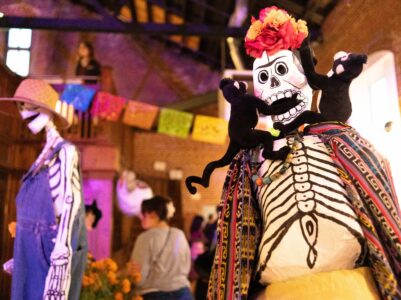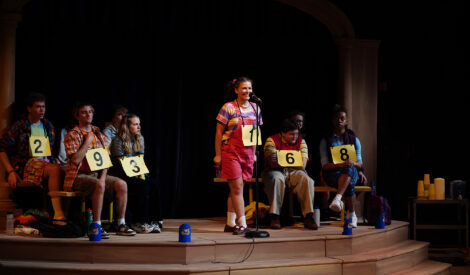As federal cuts threaten humanities funding, Watkins Museum leader hopes the county and community will support historic sites

photo by: Bremen Keasey
Displays on the second floor of the Watkins Museum, 1047 Massachussetts St. As the Watkins Museum faces the threat of losing nearly $80,000 in federal funds a year — and federal changes limiting the type of projects that are grant-supported — the museum is looking at all solutions to close the funding gap.
This month, the Watkins Museum of History is celebrating its 50th year, but it comes at a time when federal changes threaten its very existence.
Changes from the federal government have upended the museum’s operations. Steve Nowak, the museum’s executive director, said the museum has seen a drop in funds from federal sources of nearly 10%. At the same time, federal grant criteria have changed to be more restrictive about what kinds of historic displays receive funding, which makes it harder to get grants for diverse and inclusive exhibits, according to Nowak.
In the face of uncertainty surrounding federal support, local heritage organizations are hoping to find creative ways to stay afloat. For the Watkins Museum, that means this month’s 50th anniversary celebration — the “Keepin’ History Alive Since ’75” gala on Nov. 20 — is on a “much larger scale” than any fundraising event the museum has ever had as the organization tries to make up for tens of thousands of dollars in lost funds.
“We’re exploring all different options,” Nowak said.
Federal grants have been crucial for the Watkins Museum’s projects, and in the past five years, Nowak said the museum has received just over $400,000 in federal funding.
Some of those funds came through the National Endowment for the Humanities. Others were regranted from state-level groups like Humanities Kansas or Freedom’s Frontier National Heritage Area. Both of those state-level groups have suspended their grant programs as they face their own funding uncertainty, Nowak said.
Nowak said the museum’s operating budget each year is around $700,000. With the federal changes, Nowak said the museum needs to “find a new source” for about $80,000 a year.
Additionally, Nowak said the criteria have changed drastically for the types of projects the National Endowment for the Humanities supports. Previously, those grants supported projects or exhibits that aimed to tell American history from a “different perspective,” Nowak said. Now, only certain kinds of projects — for example, ones that celebrate American military valor, America on the world stage or the declaration of independence, Nowak said — are getting federal dollars.
Nowak feels these criteria from the Trump administration are making it hard to fund the kinds of projects Douglas County residents want.
“It’s apparent when you look at it. Federal grants are being used to push a specific political agenda,” Nowak said.
One example of an exhibit that might not qualify for grant support under the new standard is the recently opened exhibit about George ‘Nash’ Walker, a Lawrence actor, writer and producer who revolutionized Black American theater at the turn of the 20th century. Nowak also said the museum had to put plans to expand its core exhibits to include Indigenous perspectives “on the back burner” because of the changes at the federal level.
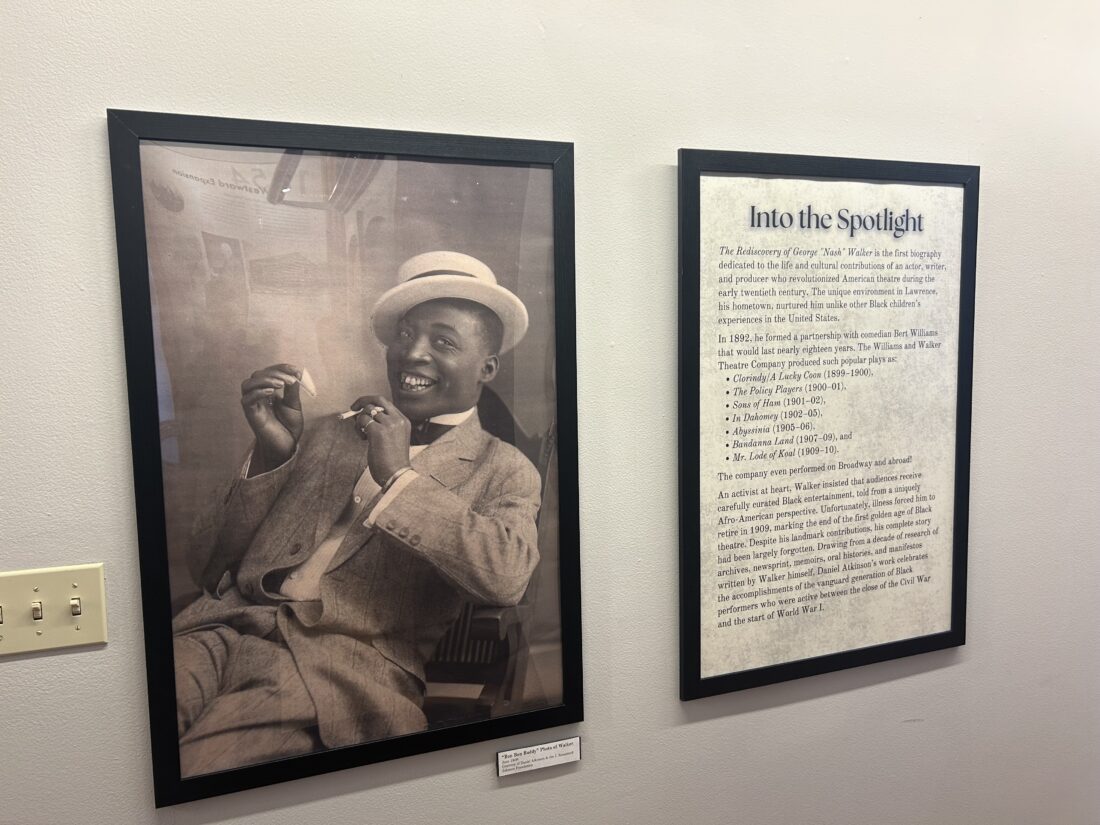
photo by: Bremen Keasey
Part of Watkins Museum of History exhibit about George ‘Nash’ Walker, a Lawrence actor, writer and producer who revolutionized Black American theater at the turn of the 20th century. Steve Nowak, the executive director of the museum, said changes to criteria for federal grants have promoted “only certain kinds of projects,” with the Walker exhibit being one that might not receive federal support.
The finances of heritage sites across the county have been stretched thin, but they aren’t fighting alone.
County commissioners formed the Douglas County Heritage Conservation Council and the Natural and Cultural Heritage Grant Program in 2011. Since then, the program has awarded over $3.2 million to heritage conservation projects across the county, according to county data. For example, the Eudora Area Historical Society has received $212,100 across six grants to refurbish the Seybold Building and turn it into the Eudora Community Museum.
Nowak said that model was similar to how the Watkins Museum came into being 50 years ago. After a community effort to restore the Watkins building led by the then-all-volunteer Douglas County Historical Society, the county “stepped in” to help.
That program has proven successful, and the Heritage Conservation Council has been working on other ways to strengthen the Watkins Museum and other heritage sites.
The council worked with Coneflower Consulting on a needs assessment to find out how to best support and promote the area’s historical heritage. During an Oct. 15 presentation, Sarah Bishop, the CEO of Coneflower Consulting, told dozens of representatives of heritage organizations there was widespread public support for cultural sites and museums in the county, but the report also found that those sites had difficulty attracting new audiences, that they had limited funding, and that their volunteers and experienced staff suffered from burnout. Those struggles are common for historic and cultural organizations across the U.S., Bishop said.
“The trends are pretty clear,” she said.
But some of the findings Bishop presented were positive for Douglas County organizations. Bishop’s research found that the top reason given by tourists for visiting Kansas was to see its historic and cultural sites.
Bishop also presented ideas to connect the disparate groups from across Douglas County into an “ecosystem.” She suggested creating a shared landing page for websites and a shared events calendar, and also proposed sharing marketing or fundraising templates and finding more ways to do co-sponsored events that can “cross-pollinate” organizations and make visitors more aware of other heritage sites.
Nowak said Douglas County is in a unique position compared to similar counties. The area’s heritage sites aren’t just concentrated in one place, and there are “all kinds of sites” — from battlefields to natural history to a museum that covers a broad range of historical topics — and all are free to visit.
“It’s a kind of in-depth experience exploring Douglas County history,” Nowak said.
With the changes in funding, Nowak feels the work from the Heritage Conservation Council comes at a good time. The findings will be presented to the Douglas County Commission during its meeting Wednesday, and he hopes it can spark a conversation about new ways to promote historic sites.
“It created an opportunity to look at things we haven’t done before,” Nowak said.
Bishop also spoke of the benefits heritage sites bring to the community — not just for those who appreciate history, but for the broader economy as well.
In her presentation, she said that all of Douglas County’s heritage sites together have an economic impact of $1.3 million. That number surprised Nowak, and he said he hadn’t thought that the community knew quite how much of an impact they generated.
“It’s hard to believe a group of little organizations can influence the community that strongly,” Nowak said.
Nowak noted sites like the Watkins Museum also have an important role in the educational system. He said that the Watkins Museum works closely with teachers and schools to create programs that bring the museum’s resources into the schools, as well as to organize field trips that work with the schools’ curricula.
Beyond that, Nowak said that museums are gathering places. The Watkins Museum regularly hosts new exhibits and seasonal events, and according to visitor surveys, people often stop by as part of a broader visit to downtown Lawrence, which is “economic impact that doesn’t get calculated,” Nowak said.
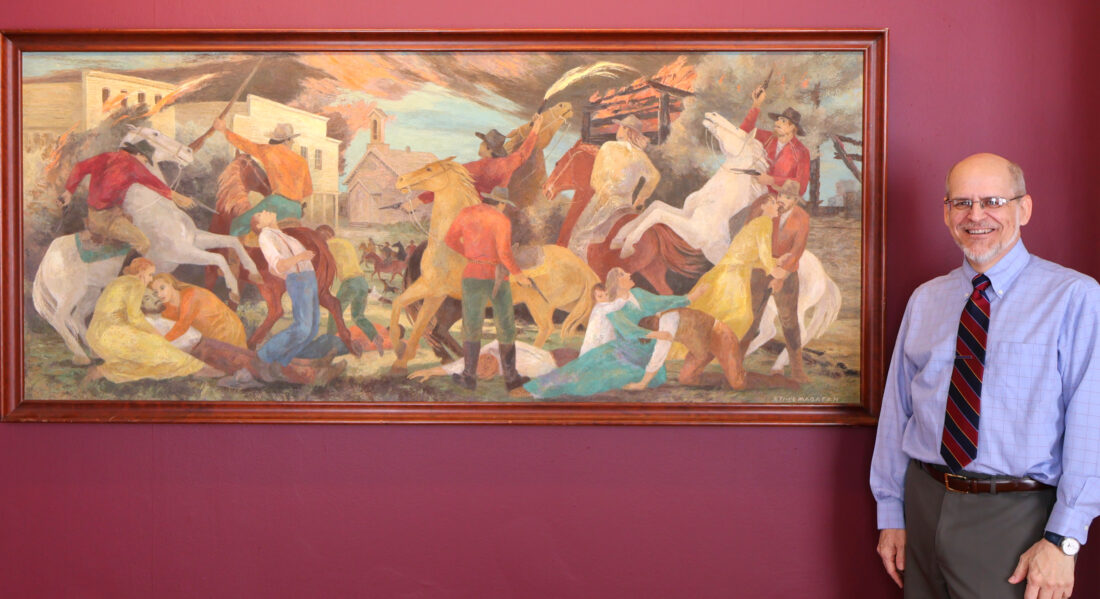
photo by: Chris Conde/Journal-World
Watkins Museum Executive Director Steve Nowak is pictured on Thursday, Aug. 16, 2024, with “Lawrence Massacre” by Ethel Magafan which is on display at the Watkins Museum of History at 1047 Massachusetts Street.
Those community benefits are part of why finding new sources to replace the lost federal funds is so crucial. The Nov. 20 gala, for which tickets are available on the Watkins Museum’s website, will include a 1970s-themed costume contest, live and silent auctions, a raffle and a ’70s dance party.
Nowak said the museum has also been exploring more sponsorships. As the Journal-World reported, it entered a sponsorship agreement with the Lawrence law firm Stevens & Brand for exhibits commemorating that firm’s 100th anniversary, the 75th anniversary of the Bert Nash Community Health Center, the muesum’s 50th anniversary, and the athletic rivalry between the University of Kansas and the University of Missouri.
In a year in which funding for history and humanities is under threat, Nowak hopes the steps the county and community are taking can keep historical sites accessible for years to come.
“This is an opportunity to look at where we are now and what would be best for moving forward … to come up with a solution that will work for the next 50 years,” Nowak said.


